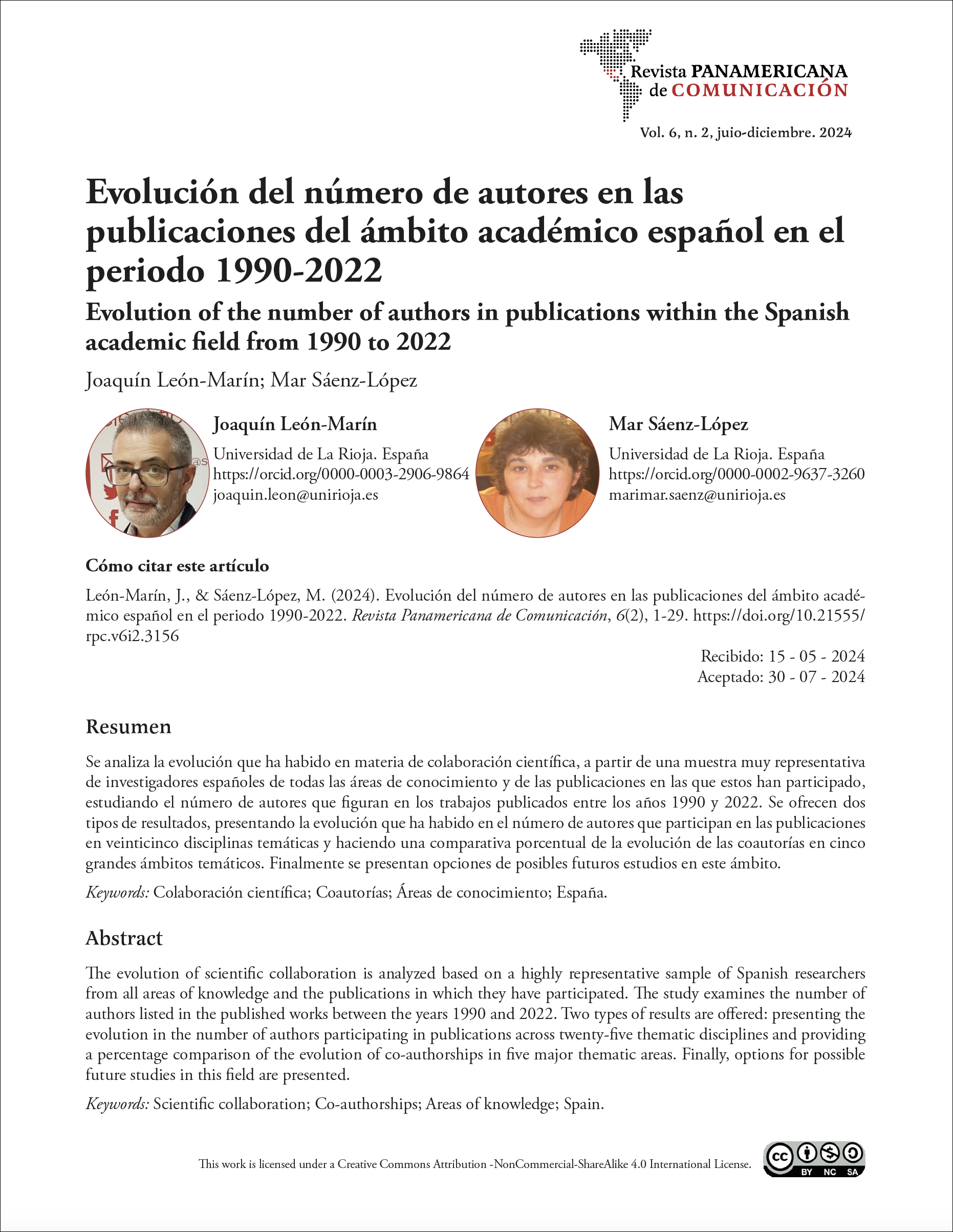Evolución del número de autores en las publicaciones del ámbito académico español en el periodo 1990-2022
Contenido principal del artículo
Resumen
Se analiza la evolución que ha habido en materia de colaboración científica, a partir de una muestra muy representativa de investigadores españoles de todas las áreas de conocimiento y de las publicaciones en las que estos han participado, estudiando el número de autores que figuran en los trabajos publicados entre los años 1990 y 2022. Se ofrecen dos tipos de resultados, presentando la evolución que ha habido en el número de autores que participan en las publicaciones en veinticinco disciplinas temáticas y haciendo una comparativa porcentual de la evolución de las coautorías en cinco grandes ámbitos temáticos. Finalmente se presentan opciones de posibles futuros estudios en este ámbito.
Detalles del artículo
Sección

Esta obra está bajo una licencia internacional Creative Commons Atribución-NoComercial-SinDerivadas 4.0.
Cómo citar
Referencias
Abramo, G., & D’Angelo, C. A. (2015). The relationship between the number of authors of a publication, its citations and the impact factor of the publishing journal: Evidence from Italy. Journal of Informetrics, 9(4), 746–761. https://doi.org/10.1016/j.joi.2015.07.003
Barabási, A. L., Jeong, H., Néda, Z., Ravasz, E., Schubert, A., & Vicsek, T. (2002). Evolution of the social network of scientific collaborations. Physica A: Statistical Mechanics and Its Applications, 311(3–4), 590–614. https://doi.org/10.1016/S0378-4371(02)00736-7
Beaver, D. B., & Rosen, R. (1978). Studies in scientific collaboration - Part I. The professional origins of scientific co-authorship. Scientometrics, 1(1), 65–84. https://doi.org/10.1007/BF02016840
Beaver, D. B., & Rosen, R. (1979). Studies in scientific collaboration - Part II. Scientific co-authorship, research productivity and visibility in the French scientific elite, 1799-1830. Scientometrics, 1(2), 133–149. https://doi.org/10.1007/BF02016966
Bukvova, H. (2010). Studying research collaboration: A Literature Review. Sprouts: Working Papers on Information Systems, 10(January 2010).
Cai, X., Fry, C. V, & Wagner, C. S. (2021). International collaboration during the Covid-19 crisis: autumn 2020 developments. Scientometrics, 126(4), 3683–3692. https://doi.org/10.1007/s11192-021-03873-7
Deci, E. L., & Ryan, R. M. (2000). The “what” and “why” of goal pursuits: Human needs and the self-determination of behavior. Psychological Inquiry, 11(4), 227–268. https://doi.org/10.1207/S15327965PLI1104_01
Delgado López-Cozar, E., & Martín Martín, A. (2024). La ruta de oro de la publicación científica: del negocio de las revistas a las revistas negocio. La fuente del negocio editorial: el negocio bibliométrico de la evaluación científica. Revista Mediterránea de Comunicación, 15(2), 393–438. https://doi.org/10.14198/MEDCOM.26763
Didegah, F., & Thelwall, M. (2013). Which factors help authors produce the highest impact research? Collaboration, journal and document properties. Journal of Informetrics, 7(4), 861–873. https://doi.org/10.1016/j.joi.2013.08.006
Franceschet, M., & Costantini, A. (2010). The effect of scholar collaboration on impact and quality of academic papers. Journal of Informetrics, 4(4), 540–553. https://doi.org/10.1016/j.joi.2010.06.003
Gazni, A., Sugimoto, C. R., & Didegah, F. (2012). Mapping world scientific collaboration: Authors, institutions, and countries. Journal of the American Society for Information Science and Technology, 63(2), 323–335. https://doi.org/10.1002/asi.21688
González-Alcaide, G., & Gómez-Ferri, J. (2014). La colaboración científica: principales líneas de investigación y retos de futuro. Revista Española de Documentación Científica, 37(4). https://doi.org/10.3989/redc.2014.4.1186
González-Alcaide, G., Gómez-Ferri, J., Agulló-Calatayud, V. (2013). La colaboración científica como objeto de estudio. In G. González-Alcaide, J. Gómez-Ferri & V. Agulló-Calatayud (Dirs). La colaboración científica: una aproximación multidisciplinar (pp. 13–15). Valencia: Nau Llibres. https://naullibres.com/wp-content/uploads/2019/07/9788476429303_L33_23.pdf
Isfandyari-Moghaddam, A., Saberi, M. K., Tahmasebi-Limoni, S., Mohammadian, S., & Naderbeigi, F. (2023). Global scientific collaboration: A social network analysis and data mining of the co-authorship networks. Journal of Information Science, 49(4), 1126–1141. https://doi.org/10.1177/01655515211040655
Jassawalla, A. R., & Sashittal, H. C. (1998). An examination of collaboration in high-technology new product development processes. Journal of Product Innovation Management, 15(3), 237–254. https://doi.org/10.1111/1540-5885.1530237
Lancho-Barrantes, B. S., Guerrero Bote, V. P., Chinchilla-Rodríguez, Z., & De-Moya-Anegón, F. (2012). Citation flows in the zones of influence of scientific collaborations. Journal of the American Society for Information Science and Technology, 63(3), 481–489. https://doi.org/10.1002/asi.21682
Lee, S., & Bozeman, B. (2005). The impact of research collaboration on scientific productivity. Social Studies of Science, 35(5), 673–702. https://doi.org/10.1177/0306312705052359
López-Borrull, A., Canals-Parera, A. (2013). La colaboración científica en el marco de nuevas propuestas científicas: Open Science,e-Science y Big Data. In G. González-Alcaide, J. Gómez-Ferri & V. Agulló-Calatayud (Dirs). La colaboración científica: una aproximación multidisciplinar (pp. 91–100). Valencia: Nau Llibres.
Marcos-Cartagena, D., Ruiz-Pérez, R., Delgado-López-Cozar, E. (2013). La producción bibliográfica sobre autoría científica. In G. González-Alcaide, J. Gómez-Ferri & V. Agulló-Calatayud (Dirs). La colaboración científica: una aproximación multidisciplinar (pp. 39–68). Valencia: Nau Llibres.
Newman, M. E. J. (2001). The structure of scientific collaboration networks. Proceedings of the National Academy of Sciences of the United States of America, 98(2), 404–409. https://doi.org/10.1073/pnas.98.2.404
Perianes-Rodríguez, A., Olmeda-Gómez, C., & De-Moya-Anegón, F. (2010). Redes de colaboración científica: análisis y visualización de patrones de coautoría. Tirant lo Blanch.
Persson, O., Glänzel, W., & Danell, R. (2004). Inflationary bibliometric values: The role of scientific collaboration and the need for relative indicators in evaluative studies. Scientometrics, 60(3), 421–432. https://doi.org/10.1023/B:SCIE.0000034384.35498.7d
Rogers, E. M., Singhal, A., & Quinlan, M. M. (2019). Diffusion of innovations. In D. W. Stacks, M. B. Salwen, & K. C. Eichhorn (Eds.). An Integrated Approach to Communication Theory and Research, Third Edition (pp. 415–433). https://doi.org/10.4324/9780203710753-35
Sheng, J., Liang, B., Wang, L., & Wang, X. (2023). Evolution of scientific collaboration based on academic ages. Physica A: Statistical Mechanics and Its Applications, 624. https://doi.org/10.1016/j.physa.2023.128846
Sonnenwald, D. H. (2007). Scientific collaboration. Annual Review of Information Science and Technology, 41, 643–681. https://doi.org/10.1002/aris.2007.1440410121
Thelwall, M., & Maflahi, N. (2022). Research coauthorship 1900–2020: Continuous, universal, and ongoing expansion. Quantitative Science Studies, 3(2), 331–344. https://doi.org/10.1162/qss_a_00188
Wuchty, S., Jones, B. F., & Uzzi, B. (2007). The increasing dominance of teams in production of knowledge. Science, 316(5827), 1036–1039. https://doi.org/10.1126/science.1136099

